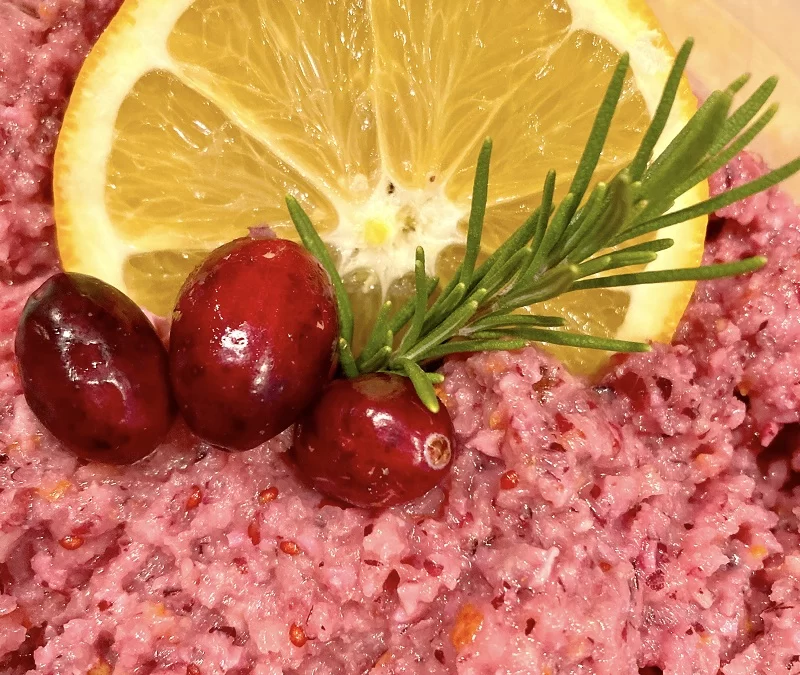Cranberry Relish
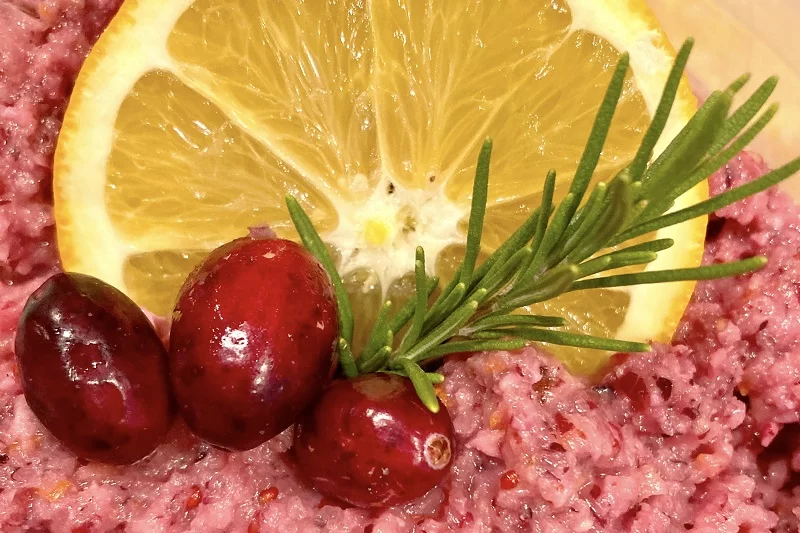
It’s a tart, ruby-red cylinder of quivering, glistening jelly, and it’s been part of America’s Thanksgiving menu since 1941. It’s estimated that Americans consume 5,062,500 gallons of jellied cranberry sauce every year, most of it at Thanksgiving dinner, but how did this ubiquitous side dish end up on American holiday tables?
Cranberries, and their European relative the lingonberry, are members of the same family as the blueberry—Vaccinium, the same genus that includes heather and manzanita—Ericaceae. Cranberries are native to the Americas and grow in mountainous and boggy soil from the Canadian maritime provinces as far south as Georgia, and as far west as Minnesota, while lingonberries grow in both Northern Europe and parts of North America.
Cranberries thrive in New England, in the acidic, boggy soils left behind by the retreating ice age. Indigenous peoples, including the Wampanoag people, have a history of gathering and cultivating cranberries for millennia before European colonists arrived in the seventeenth century.
The colonists were slow to develop an appreciation of the tart fruit. Although it has been traditional for more than two centuries to eat cranberry sauce at Thanksgiving and Christmas, this dish did not gain popularity until the arrival of inexpensive and abundant sugar, which means it was probably not served as part of the meal celebrated as the first Thanksgiving, although some food historians speculate that it could potentially have featured as part of the dressing for the wild birds consumed.
Amelia Simmons, author of the Art of Cookery, published in 1796, provides the first known reference to cranberries as an accompaniment to turkey: she recommends: serving the bird with “onions and cranberry sauce, mangoes, pickles or celery,” but doesn’t provide a recipe, presumably because her readers would know how to make the sauce. The mangoes would almost certainly have been pickled—a luxury item in vogue in the 18th century so popular that the name of the fruit became synonymous with pickling—“mangoed walnuts” were a thing, so was “mango of cucumbers,” which we would just call “pickles,” today.
Simmons also featured a cranberry tart in her book. The fruit should be “stewed, strained and sweetened, put into paste[ry] and baked gently.” Those short instructions are the first known recipe featuring the American cranberry. Simmons’ book was a much bigger first: the first cookbook written by an American, remarkable also for having been written by a woman for a female audience.
Cranberries remained a seasonal treat in the Northeast, where they were gathered wild until the early 1800, when the fruit began to be cultivated in the Cape Cod area of Massachuchets. An entrepreneur named Marcus L. Urann is credited with creating the market for canned cranberry juice and that ubiquitous Thanksgiving dinner staple, canned jellied cranberry sauce. Urann, a New England lawyer-turned-farmer, bought a cranberry bog in 1912 and set about creating a bigger market for the berries.
There was already demand for fresh berries, but the season was short—just a few weeks in late autumn, and the fruit only thrives in cold climates and acidic, boggy soil. Urann began looking for ways to preserve the berries and create a year-round market. He helped found the National Cranberry Association, which changed its name to Ocean Spray in 1957. Cranberry cocktail juice appeared on the market for the first time in 1933, followed by canned cranberry jelly in 1941—just in time to enliven wartime holiday meals.
Ocean Spray is still dominates the cranberry business. Today, it is a cooperative of 600 independent growers, who continue to fulfill America’s need for canned jelly. They’ve also expanded the market to include “craisins”, dried, sweetened cranberries, and a variety of cranberry-flavored juice beverages, but the vast majority of cranberries end up in cocktail juice or in that cylinder of jelly on the Thanksgiving table. It’s a holiday tradition as American as the berry that it is made from.
We always had that ubiquitous canned cranberry jelly at thanksgiving when I was a child—it was a hard-fought honor to be the one given the responsibility of getting it out of the can in a perfect cylinder, with the ridges still neatly impressed on the sides, but we always had fresh cranberry relish, as well.
Making this seasonal treat was my big brother Christopher’s responsibility. As a pesky little sister, it was my job to crack the walnuts and pick the nuts out of the shells, while he had the awesome responsibility of operating a meat grinder that, as far as I remember, was only ever used to grind up the annual batch of relish, and on one occasion, some rather ill-fated deviled ham.
It’s an easy recipe, but a good one. I don’t know where my mom found it. Looking through her cookbooks, I found a recipe for cranberry relish with oranges, and one with apples, but not one with both, and not one that also had walnuts in it. Perhaps she made it up. She was a great cook.
We are mostly vegans around here these days, and many of the traditional holiday recipes have been swapped out for non carnivorous versions, but this one is a great option for carnivores and herbivores, alike. My brother ended up with the meat grinder, so I use the food processor, but it is also possible to prepare this by hand, although the texture will be chunkier.
~Suzanne Guldimann
Recipe for Cranberry Relish
1 bag of cranberries, washed and picked through to remove squishy berries.
2 navel oranges (organic if possible, because the whole orange will be used, peel and all)
1-2 apples, red, yellow, or green
1 cup walnuts (omit if nut allergies are a problem, and feel free to substitute pecans, almonds or hazelnuts)
Sugar to taste: 1/2 cup usually works well, but it depends on how sweet the apples and oranges are.
Chop the walnuts, and set aside—they are easier to chop if the food processor is dry. They should be chopped fine but not turned into flour or paste
Chop the cranberries. Quarter and core the apples, and chop. Quarter the oranges and make sure all seeds are removed, and chop
When everything is coarsely chopped, mix the fruit and nuts with the sugar and put everything back in the food processor for one last round. The texture should be smooth, but not pureed.
This is a flexible recipe. Substitute maple syrup for the sugar. Try adding lemons, kumquats, fresh ginger, a dash of cinnamon, or a splash of madera or rum for a different twist. My mom would approve. She was always experimenting!
This relish can be prepared in advance, and tastes even better the second day. It can be refrigerated for up to a week, and freezes well. Leftovers make a great topping for oatmeal, and other hot cereals, or for yogurt or even ice cream.
Savory Stuffing-Seasoned Buttons
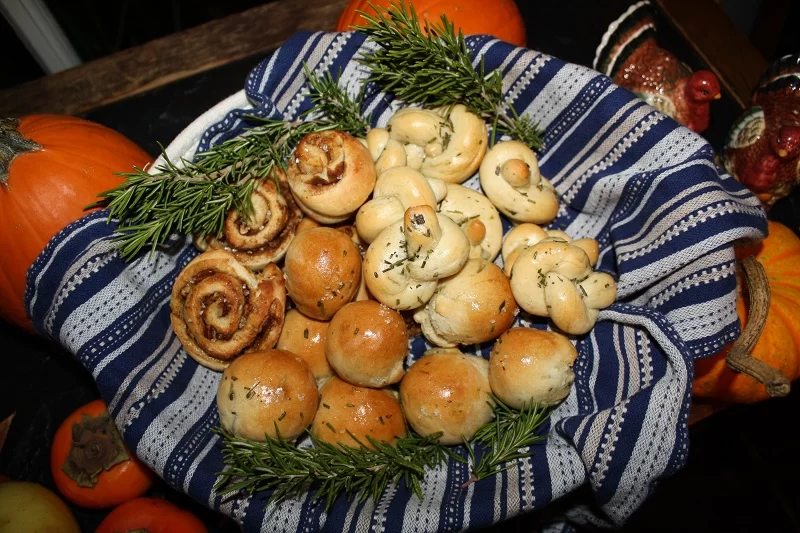
Recipe for Savory Stuffing-Seasoned Buttons
Makes 12 buttons
This recipe has been adapted from a simple family pizza dough recipe my aunt and I love to make rosemary herb knots out of. It’s a great savory little roll that works well as dinner rolls or as a snack while cooking Thanksgiving dinner. The spices can alternatively be swapped out for cheddar cheese and jalapenos for a spicy version, or try adding a dusting of pumpkin pie spice and chopped walnuts.
2 cups bread flour, or all purpose flour
3/4 cup warm water
1 packet Active Dry Yeast
1 1/2 tsp salt
Poultry seasoning
Fresh sage
Fresh rosemary
Fresh thyme
Olive Oil
Sea Salt
- Combine the water and yeast in a measuring cup, stir until well combined. In a large mixing bowl, combine flour and salt. Slowly add water and yeast to the bowl while mixing.
- Mix until a loose dough forms.
- Knead dough until smooth, about 10 minutes. Place dough in a lightly oiled bowl and flip to coat. Cover with a tea towel and let rise in a warm place for an hour, or until doubled in size.
- While dough rises, combine poultry seasoning, sage, rosemary, and thyme to taste in a small bowl, set some aside for garnish and knead the rest into risen dough. Section dough into 12 ping pong ball-sized sections, and shape into rolls, knots or spirals.
- Arrange on a greased cookie sheet or on parchment paper.
- Cover the rolls and allow them to rest and rise for half an hour.
- Bake at 425 degrees for 8-10 minutes or until golden brown.
- Brush with olive oil while hot and sprinkle with herbs and sea salt.
~Elizabeth Guldimann
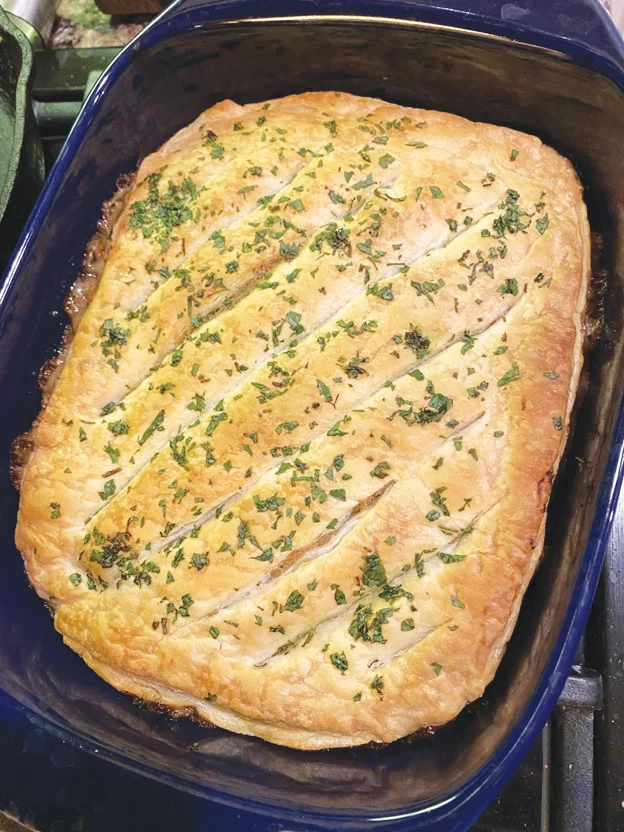
well baked in a cast-iron skillet, or even in individual ramekins. Photos by Claire Chapman
Cozy Vegan Pot-Pie
For meat-eaters out there, it can be puzzling to imagine what a vegan or vegetarian eats on Thanksgiving. There are more meat-substitutes available than ever before, but some of the best holiday food is not trying to replace meat. Setting turkey aside, there are plenty of flavorful dishes that can make this meal memorable. This Cozy Vegan Pot-Pie is great to add to a plate of mashed potatoes, mushroom gravy, and cranberry sauce.
This recipe can be modified to highlight different seasonal vegetables and herbs like delicata squash and sage, or asparagus and potatoes with tarragon. The crispy, fluffy puff-pastry tops any combination beautifully, whether in small ramekins or over a cast iron skillet. Whatever the season, this comfort food packs a nutritional punch with an assortment of vegetables.
~Claire Chapman
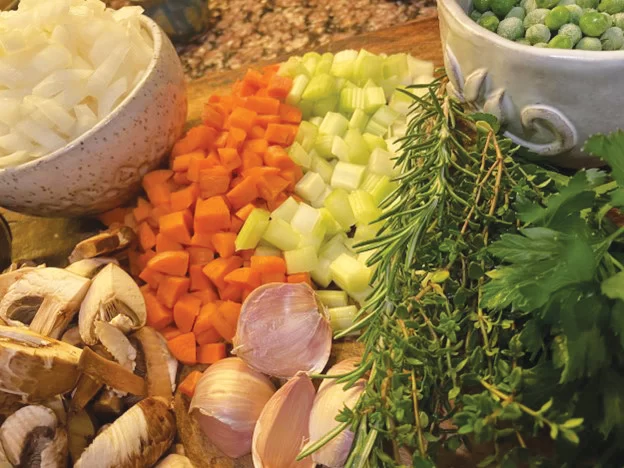
can be adapted to work with many different herb and vegetable combinations.
8 oz quartered cremini mushrooms
4-8 oz sliced Shitake mushrooms
¼ cup all-purpose flour
1 diced onion
1 cup diced carrots
1 cup diced celery
4-5 cloves minced garlic
½ cup frozen peas
1½ tablespoons of minced fresh rosemary
1½ tablespoons of minced fresh thyme
1 cup vegetable broth (more if needed)
¼ cup of cashew cream (to make: soak raw cashews for 30 minutes and then blend in a high-power blender until smooth)
1-2 tablespoons soy sauce
Salt and pepper to taste
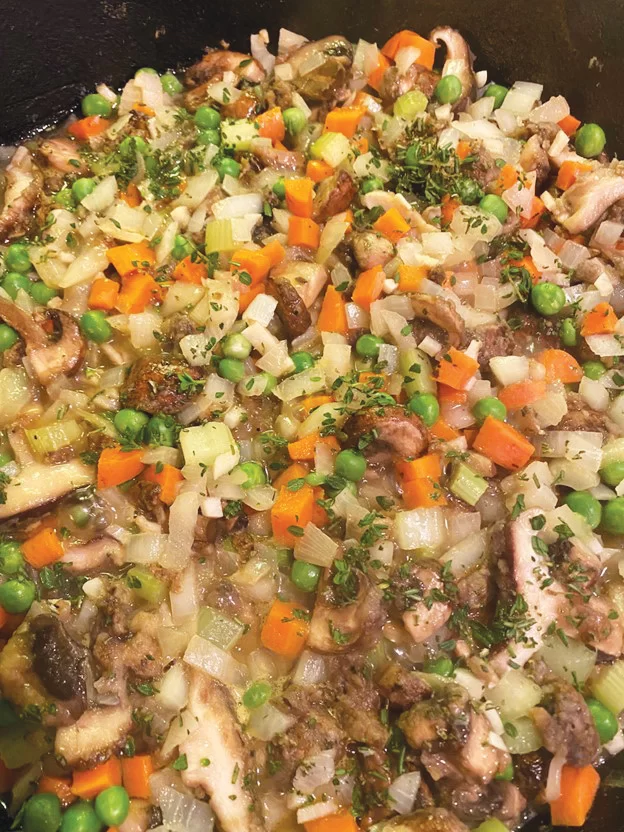
sauce. If you’re short on time, make the pie-filling in advance so this dish can be quickly put together
and baked.
- One sheet of vegan puff-pastry (room temperature) Preheat the oven to 425 degrees.
- Toss the sliced mushrooms in the flour, salt, and pepper. Heat the olive oil in a pot or skillet and sauté the coated mushrooms until they begin to brown. Remove the mushrooms and set aside.
- Add more olive oil to the pan and sauté the carrots, celery, garlic, and onion until they are softened, but not browned.
- Add the mushrooms, fresh peas, half of the herbs, and the broth. Simmer for about 15 minutes.
- Remove from heat. Add the cashew cream, remaining herbs, soy sauce, and more broth if needed. Add more soy sauce, salt, or pepper to taste. Transfer the filling to a large baking dish (individual ramekins or cast iron skillet can both also work).
- Spread out the puff-pastry and cut slits into it to allow steam to be released during baking. Carefully lay the puff-pastry over the pie filling in the dish, spreading it out to cover.
- Bake at for 30-40 minutes, until the puff pastry is golden.






